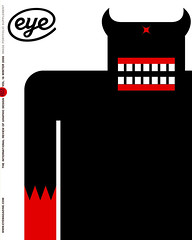Winter 2006
Advertising’s second coming
Advertising is dead. Long live advertising!
By Tom Himpe Thames Hudson, £29.95This book provides a succinct overview of alternative advertising strategies that have become prominent in the past decade. By summarising and describing different approaches, Himpe illuminates processes lying behind attention-grabbing campaigns and strategies. The point of these strategies is to capture the attention, even admiration, of a sophisticated, advertising-saturated audience.
Himpe’s basic premise is that since the mid-1990s, the traditional media of television, magazines, newspapers and billboards are no longer effective in reaching their target audiences. He quotes the fact that, twenty years ago, three commercials would reach 80 per cent of the American audience, but today it would take 150 commercials to reach the same audience. In the contemporary multi-channel, multimedia environment audiences are fractured and also overwhelmed with choice. New technology has enabled consumers to switch off and tune out advertising. More importantly, the majority of consumers are jaded by advertising: they are sophisticated, bored and alienated by hard sell and conventional strategies.
The challenge for contemporary advertisers wanting to engage with their audiences is in devising ways of capturing their attention, entertaining them and impressing them through cleverness and panache. Himpe states there are four key drivers of alternative advertising: proximity, exclusivity, invisibility and predictability; and eight key strategies that characterise the field: intrusion, transformation, installation, illusion, infiltration, sensation, interaction and stunt. The bulk of the book is made up of examples of these strategies, with the largest sections being intrusion and illusion. It also reflects the other key drivers of alternative advertising: wit and intelligence. He ends the book with some guidelines for building campaigns and ‘twenty pointers to start you thinking’.
When Himpe states that there are ‘more than six billion potential media units on the planet’, read that as ‘potential consumers’. In fact, he is really addressing the strategies targeting the affluent, largely younger market of industrialised countries or urban capitals of places such as South Africa and Brazil. The case studies include many multinational companies and the multinational agencies that serve them, but there is also a good range of small-scale clients and agencies. There is a significant number of campaigns for social issues by organisations such as Amnesty International, and examples of guerilla tactics, such as the guy who took on Apple over the first generation of iPods, which were powered by non-replaceable batteries that lasted just eighteen months.
The book is written in a casual, accessible style, and quotes and key points are in bold for those with short attention spans. He does not prove his claim that alternative advertising, rather than being ‘the cherry on the cake’, actually ‘is the cake’. In fact, his examples highlight the real difficulty in assessing the impact of alternative advertising, both in terms of the number of people reached and the quality of the impact. The strength of alternative advertising comes when its ‘amplification effect’ is high – in other words when the advertising idea captures the attention of mainstream media and gets high levels of editorial coverage. However, this does not happen often, and if it did, it would suffer from the same problems of overload and consumer alienation. It only works through novelty, and often that novelty is the product of big budgets and top agencies, even if the campaign itself is cheap – Richard Branson’s stunts being a key example.
The book provides an entertaining and informative overview of recent trends in advertising. Apart from its interest for those in the industry, it provides a comprehensive overview that is also an excellent educational tool in showcasing really creative thinking at the cutting edge of the field.
Lynne Ciochetto, associate professor, Massey University, Wellington, NZ
First published in Eye no. 62 vol. 16 2006
Eye is the world’s most beautiful and collectable graphic design journal, published quarterly for professional designers, students and anyone interested in critical, informed writing about graphic design and visual culture. It is available from all good design bookshops and online at the Eye shop, where you can buy subscriptions and single issues.

